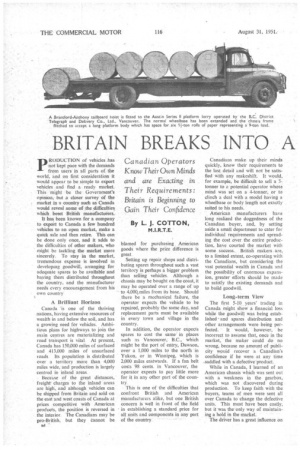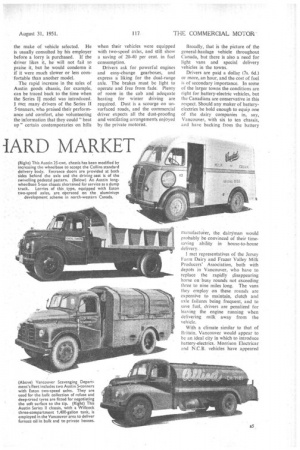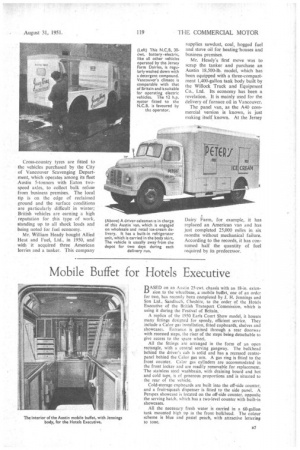BRITAIN BREAKS INTO A IARD MARKET
Page 38

Page 39

Page 40

Page 41

If you've noticed an error in this article please click here to report it so we can fix it.
Canadian Operators Know Their Own Minds and are Exacting in Their Requirements: Britain is Beginning to Gain Their Confidence
By L. J. COTTON, m.1.R.T.E.
pRODUCTION of vehicles has not kept pace with the demands from users in all parts of the world, and on first consideration it wouldappear to be simple to export vehicles and find a ready market. This might be the Government's opinion, but a closer survey of the market in a country such as Canada would reveal some of the difficulties which beset British manufacturers.
It has been known for a company to export to Canada a few hundred vehicles to an open market, make a quick sale and then retire_ This can be done only once, and it adds to the difficulties of other makers, who might be tackling the market more sincerely. To stay in the market, tremendous expense is involved in developing goodwill, arranging for adequate spares to be available and haying them distributed throughout the country, and •the manufacturer needs every encouragement from his own country
A Brilliant Horizon
Canada is one of the thriving nations, having extensive resources of wealth in and below the soil, and has a growing need for vehicles. Ambitious plans for highways to join the main centres are materializing and road transport is vital At present, Canada has 150,000 miles of surfaced and 413,000 miles of unsurfaced roads Its population is distributed over a territory more than 4,000 miles wide, and production is largely centred in inland areas.
• Because of the great distances, freight charges to the inland areas are high, and although vehicles can be shipped from Britain and sold on the east and west coasts of Canada at prices competitive with American products, the position is reversed in the interior. The Canadians may be pro-British, but they Cannot be n4 ' blamed for purchasing American goods where the price difference is great
Setting up repair shops and distributing spares throughout such a vast territory is perhaps a bigger problem than selling vehicles. Although a chassis may be bought on the coast, it may be operated over a range of up -to 4,0001miles from its base. Should .there be a mechanical failure, the operator expects the vehicle to be repaired, probably the same day, and replacement Parts must be available in every town and village in the country.
In addition, the operator expects spares to cost • the same in places. such as Vancouver, B.C., which might be the port of entry, Dawson, over a 1,000 miles to the north in Yukon, or in Winnipeg, which is 2,000 miles eastwards. If a fan belt costs 98 cents. in Vancouver, the operator expects to pay little more for it in any other part of the country.
This is one of the difficulties that confront British and American manufacturers alike, but one British concern is well in front of the field in establishing a standard .price for all units and c-omponents in any part
of the country '
Canadians make up their minds quickly, know their requirements to the last detail and will not be satisfied with any makeshift. It would, for example, be difficult to sell a 5tonner to a potential operator whose mind was set on a 4-tonner, or to clinch a deal with a model having wheelbase or body length not exactly suited to his needs.
American manufacturers have long realized the doggedness of the Canadian buyer, and, by setting aside a small department to cater for individual requirements and spreading the Cost over the entire production, have courted the market with some success. British makers .are, to a limited extent, co-operating with the Canadians, but considering the vast potential wealth in Canada and the possibility of enormous expansion, greater efforts should be made to satisfy the existing demands and to build goodwill.
Long-term View The first 5-10 years' trading in Canada might show a financial loss while the goodwill was being established • and spares distribution and other arrangements were ,being perfected. It would, •however,
incorrect to assume that, once in the market, the maker could do no wrong, because no amount of publicity would recover a Canadian's confidence if he were. at any time .saddled with a defective product..
While in Canada, I learned of an American chassis which was sent out with a weakness in the gearbox, which was not discovered during production. To keep faith with the buyers, teams of men were sent all over Canada to change the defective units. This must have been costly, but Wm/as theOnly way of maintaining a hold in the market.
The driver has a great influence on
the make of vehicle selected. He is usually consulted by his employer before a lorry is purchased. If the driver likes it, he will not fail to praise it, but he would condemn it if it were much slower or less comfortable than another model.
The rapid increase in the sales of Austin goods chassis, for example, can be traced back to the time when the Series II model was introduced. I met many drivers of the Series II 5-tonners, who praised their performance arid comfort, also volunteering the information that they could "beat up" certain contemporaries on hills when their vehicles were equipped with two-speed axles, and still show a saving of 20-40 per cent. in fuel consumption.
Drivers ask for powerful engines and easy-change gearboxes, and express a liking for the dual-range axle. The brakes must be light to operate and free from fade. Plenty of room in the cab and adequate heating for winter driving are required, Dust is a scourge on unsurfaced roads,. and the commercial driver expects all the dust-proofing and ventilating arrangements enjoyed by the private. motorist. Broadly, that is the picture of the general-haulage vehicle throughout Canada, but there is also a need for light vans and special delivery vehicles in the towns.
Drivers are paid a dollar (7s. 6d.) or more, an hour, and the cost of fuel is of secondary importance. In some of the larger towns the conditions are right for .battery-electric vehicles, but the Canadians are conservative in this respect. Should any maker of batteryelectrics be bold enough to equip one of the .dairy companies in, say, Vancouver, with six to ten chassis, and have backing from the battery
manufactuier, the, dairYman would probably be convinced of their timesaving ability in house-to-house delivery..
I met representatives of the Jersey Farm Dairy and Frazer Valley Milk Producers' Association, both with depots in Vancouver, who have to replace the rapidly disappearing horse on busy rounds not exceeding three to 'nine miles long. The vans they employ on these rounds are expensive to maintain, clutch and axle failures being frequent, and to save fuel, drivers are penalized for leaving the engine running when delivering milk away from the vehicle.
With a climate similar to that of Britain, Vancouver would appear to be an ideal city in which to introduce battery-electrics. Morrison Electricar and N.C.B. vehicles have appeared
singly in the area, but, in my estimation, the manufacturers should make bolder plans.
At present the Jersey Farm Dairy is also employing Divco stand-updrive 1-tanners—models which are specially designed for door-to-door work_ The Divco has a swept-down frame at the centre, steering-column gear change, combined clutch-andbrake pedal, and two hand-brake levers, one of which is interconnected with the foot-brake. The transport manager spoke highly of this model. Two British manufacturers are preparing to give competition to the Divco, and they should have little difficulty in undercutting its price, which is high.
Frazer Valley Milk Producers' Association and Crystal Dairies, Ltd., have recently purchased some Austin 25-cwt. chassis, modified to accept the Collins standard dairy body. Alterations to the chassis include an 11-in. increase of wheelbase, which provides space for an entrance behind the front wheels.
• The Collins body affords twothirds load space, and the remainder is taken up by the cab and platform, with full-height sliding doors at each side behind the driving seat. This arrangement saves time when working in a heavily populated area.
The Austin 24ennets of the Series Ii range have not long made their appearance, and during a brief visit I had little time to contad operators Of them. From my own experience
of driving a model of this ,type over 1,000 miles, including crossing the Rocky Mountains, I am sure 'it will be popular.
Perhaps the highest praise of the 2-tanner (13,500 lb. gross weight in the Canadian market) came from Mr. Fred Smith, transport manager of the Frazer Valley Association. He ha's two of these vehicles operating 200 miles away from Vancouver--" out in the wilds," _ as he describes it— and although they have been working seven days a week for -The 'past. six months, not a single mechanical.failure has been reported. Mr. Smith laconically remarked that his people out in the wilds would soon have let him know had there been the slightest fault to find.
Probably the best-seller An the commercial range is the 5-former, which is rated in Canada at 18,500 lb. gross weight, but can often be seen carrying. 8-10-ton payloads. This model was put on trial, in competition with American vehicles of a similar type, in the Yukon aluminium development scheme.
Although the Austin had a smaller engine than its competitors, it took only a minute longer over a difficult course, including climbing long gradients. The fuel-consumption return was 3 m.p.g. better than any of its competitors and the contract was awarded to the British concern. I much regretted that I could not travel 1,000 miles up-country to see these vehicles, equipped with crosscountry tyres, operating under some of the worst possible conditions.
Mainly, the standard 13-ft. 1-in.wheelbase load carriers are employed for general haulage, and 9-ft. 7-in.wheelbase models are used for tipping work, but modifications have been made in other cases specifically to meet operational requirements.
The B.C. District Telegraph and Delivery Co., Ltd., for example, required a lorry with a long body to carry six rolls of newsprint. This required an alteration to the Austin wheelbase and frame-stiffening between the • axles.
Vehicles supplied for this work are equipped with Brantford-Anthony hydraulic tailboard hoist' ge,ar and a platform body built by Pioneer Equipment. (1945), Ltd. An Austin Series. II chassis with an Eaton twospeed axle is employed, and as each roll of newsprint weighs approximately 11 tons, the payload is 9 tons.
An extended • chassis of the same type is also popular for furniture removals, and two Vancouver con cerns, Reid's Moving and Storage, and Pease Van and Storage, have had 20-ft. bodies fitted.
lee-cream sales in Canada boom all through the year. Peter's Ice Cream Co., Ltd., Vancouver, uses an Austin 5-tonner with a van body having a built-in refrigerating unit for wholesale and retail delivery of its products. As in other Austin models in Canada, Smith twin heaters are supplied in the cab.
"The refrigerator is neatly installed in the body skirt and is connected to the main supply when the vehicle is garaged at night Normally, the vehicle is loaded overnight and leaves the garage early in the morning ,on a two-day delivery, round. Cross-country tyres are fitted to the vehicles purchased by the City of Vancouver Scavenging Department, which operates among its fleet Austin 5-tonners with Eaton twospeed axles, to collect bulk refuse from business premises. The local tip is on the edge of reclaimed ground and the surface conditions are particularly difficult in winter; British vehicles are earning a high reputation for this type of work, standing up to all shock loads and being noted for fuel economy.
Mr. William Heady bought Allied Heat and Fuel, Ltd., in 1950, and with it acquired three American lorries and a tanker. This company
supplies sawdust, coal, hogged fuel and stove oil for heating-houses and business premises.
Mr. Heady's first move was to scrap the tanker and purchase an Austin 18,500-lb. model, which has been equipped with a three-compartment 1,400-gallon tank body built by the Willock Truck and Equipment Co., Ltd. Its economy has been a revelation. It is mainly used for the delivery of furnace oil in Vancouver.
The panel van, as the A40 commercial version is known, is just making itself known. At the Jersey Dairy Farm, for example, it has replaced an American van and has just completed 25,000 miles in six months without mechanical failure. According to the records, it has consumed half the quantity of fuel required by its predecessor.




















































































